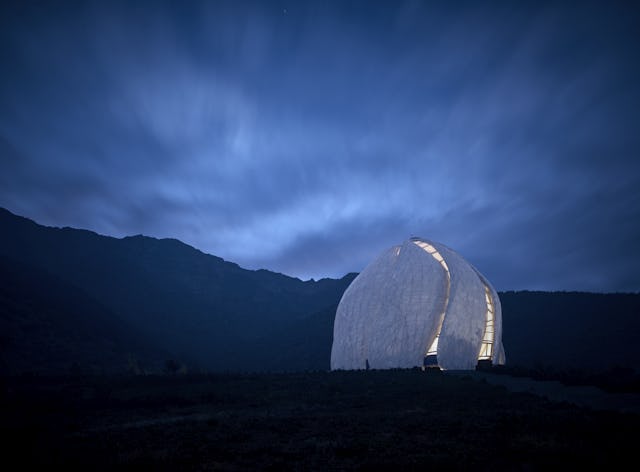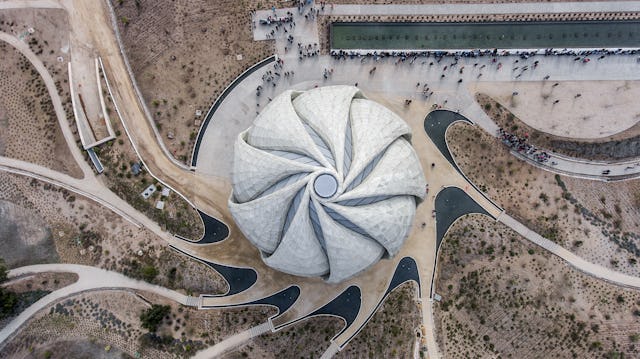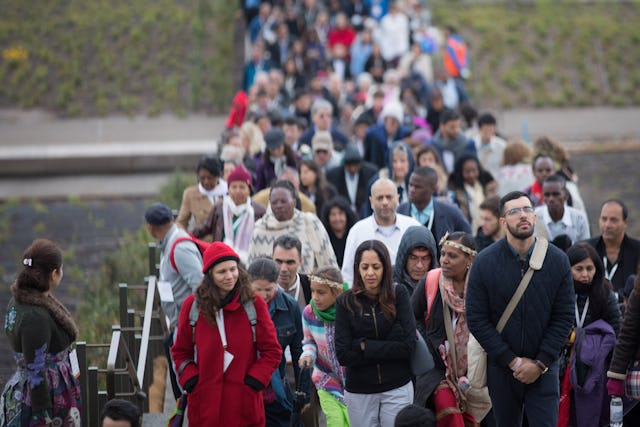“The hand of the community crafted the outcome”: Baha’i House of Worship receives prestigious international prize
TORONTO — The prestigious biennial Royal Architectural Institute of Canada (RAIC) International Prize is not a typical architectural award.
An international jury of six highly distinguished architects has to choose a building that stands out for being “transformative within its societal context” and “expressive of the humanistic values of justice, respect, equality, and inclusiveness.” This they have to do from among an extraordinary selection of architectural structures from around the world that have impacted the social life of the communities within which they were built.
This year’s RAIC International Prize of $100,000 was awarded to the Bahá’í House of Worship for South America. The prize money is being dedicated to the long-term maintenance of the Temple. Commissioned by the Universal House of Justice and designed by Canadian architect Siamak Hariri, the House of Worship for South America has become an iconic symbol of unity for Santiago and well beyond. Overlooking the city from the foothills of the Andes, the Temple has received over 1.4 million visitors since its inauguration in October 2016. The House of Worship has not only symbolized unity but it has given expression to a powerful conviction that worship of the divine is intimately connected with service to humanity.
The connection between the built environment and the well-being of society was a preeminent concern for the Jury of the RAIC Prize. Diarmuid Nash, the Jury Chair, explains that three architectural projects were selected as finalists for the transformative impact they had on their respective communities. “The Bahá’í Temple was a community project. Numerous volunteers worked on this project, similar to a way a community project works in a small village, but this was on a global scale.”
“But the Temple went beyond the community,” he continues. “It extended the principles of the Bahá’í Faith—that every person is equal, that every person can come here to reflect and regenerate. It had this impact that rippled beyond the community and attracted more and more people from all walks of life.”
The process of selection was rigorous and extended over six months. Jury members were asked to perform site visits as part of their research and selection process. “We asked Stephen Hodder, former President of the Royal Institute of British Architects and guest Juror, to visit this project,” says Mr. Nash. “We thought he would have a dispassionate eye.”
Mr. Hodder visited the Temple for three days earlier this year and spent a significant amount of time with the local community. He later shared his impressions with the Jury, referring to the House of Worship as “truly transformational, timeless and spiritual architecture, the like of which I have never experienced, and the influence of which extends way beyond the building.”
Speaking about Mr. Hodder’s visit, Mr. Nash says “Stephen said to me that he had not felt such an emotional impact since he had walked into Ronchamp, which is a very famous chapel all of us have visited in our architectural careers. It is a touchstone of modern architecture. He said ‘this goes beyond Santiago, it reaches out to the world.’”
Mr. Hodder in his comments to the Jury shared the following thoughts:
"How can it be that a building captures the spirit of ‘unity,’ a sacred place, or command a prevailing silence without prompting? The interior space spirals upwards vortex-like culminating with the oculus within which is the inscription ‘O Thou Glory of the Most Glorious’. Seating orientates to Haifa and the Shrine of the Báb, the forerunner of Bahá’u’lláh…. But why do people flock to the Bahá’í Temple? Is it the garden, planted with native species and lovingly cared for by volunteers, or the view over Santiago and remarkable sunsets, or the curious object set against the mountains? The Temple is the anchor…At night, the opacity of the cast glass outer skin, and the translucency of the Portuguese marble inverts, and the dome appears to glow ethereally from the inside…. The Temple has not only afforded a focus for the Bahá’í community but in their commitment to ‘service’ also for the neighbourhood and its well being."
It was not only the impact of the Temple on society but also the nature of its craftsmanship that struck the Jury. “It was lovingly assembled,” says Mr. Nash. “The woodwork, the stonework, and the glasswork—they all have the sense of a hand shaping them, which is remarkable for a project so sophisticated. This had a powerful impact on the Jury. There was this sense that the hand of the community had crafted the outcome.”
In the wake of the award, Mr. Hariri has been reflecting on the endeavour. “Hundreds of people sacrificially worked on this project with great dedication, enormous skill, and put themselves forward at the very frontier of what’s possible in architecture,” he explains.
“The Temple reflects an aspiration. What architects do is put into form aspiration. When you have a chance like this, where the aspirations are so great, it requires the furthest reaches of imagination to meet that challenge.”
The award was presented on 25 October at a ceremony at the Westin Harbour Castle in Toronto. “Above all,” said Mr. Hariri in remarks he made that evening, “our gratitude extends to the Universal House of Justice which was our unwavering source of guidance, courage, and constancy.”
Mr. Nash, who was there, says that as the talk finished people were standing and cheering. “We were all very inspired. It’s a project that has a life of its own. It is supposed to be a building built to last 400 years. I suspect it will go well beyond that.”


